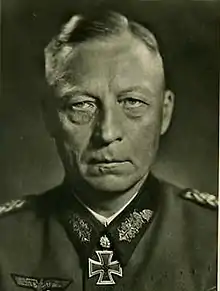Karl Allmendinger
Karl Allmendinger (3 February 1891 – 2 October 1965) was a general in the Wehrmacht of Nazi Germany during World War II. He commanded the 5th Infantry Division, V Army Corps then 17th Army on the Eastern Front. He was a recipient of the Knight's Cross of the Iron Cross with Oak Leaves.
Karl Allmendinger | |
|---|---|
 | |
| Born | 3 February 1891 Abtsgmünd, Kingdom of Bavaria, German Empire |
| Died | 2 October 1965 (aged 74) Ellwangen, West Germany |
| Allegiance | |
| Service/ | Army |
| Years of service | 1910–45 |
| Rank | |
| Commands held | |
| Battles/wars | World War II |
| Awards | Knight's Cross of the Iron Cross with Oak Leaves |
Career
Allmendinger was appointed to command the 5th Infantry Division as a Generalmajor on 25 October 1940.[1] His division was committed to the invasion of the Soviet Union in June 1941, and he was awarded the Knight's Cross of the Iron Cross on 17 July.[2] He was promoted to Generalleutnant on 1 August 1942,[1] and was awarded the Oak Leaves to his Knight's Cross on 13 December 1942.[2] He was relieved of command of the division on 4 January 1943.[1]
On 1 July 1943 he was recalled into active service and appointed commanding general of the V Army Corps which operated in the Crimea. Assigned to command the 17th Army in early May 1944, his mission was to evacuate Sevastopol and lead his units back to Romania across the Black Sea. Considerable losses in men and material were suffered.
On 25 July 1944, Allmendinger was again relieved from command and transferred to the Führerreserve, where he remained without further assignment until the end of the war. He was arrested by U.S. forces in 1945 but released in 1946.
Allmendinger was the son of Karl Allmendinger (Author) (1863 – 1946), a teacher, poet and writer.
Awards
- Clasp to the Iron Cross (1939) 2nd Class (20 September 1939) & 1st Class (21 May 1940)[3]
- Knight's Cross of the Iron Cross with Oak Leaves
- Knight's Cross on 17 July 1941 as Generalmajor and commander of the 5. Infanterie-Division[2]
- 153rd Oak Leaves on 13 December 1942 as Generalleutnant and commander of the 5. Jäger-Division[2]
3rd Class of the Lithuanian Grand Duke Gediminas Order (16 February 1928)
References
Citations
- Mitcham 2007, p. 240–241.
- Scherzer 2007, p. 190.
- Thomas 1997, p. 4.
Bibliography
- Bradley, Dermot (1993). Die Generale des Heeres 1921–1945. Die militärischen Werdegänge der Generale, sowie der Ärzte, Veterinäre, Intendanten, Richter und Ministerialbeamten im Generalsrang. Band 1: Abberger–Bitthorn [The Generals of the Army from 1921 to 1945. The Military Careers of the Generals, and the Doctors, Veterinarians, Directors, Judges and Ministry Officials in the rank of General. Volume 1: Abberger-Bitthorn] (in German). Osnabrück: Biblio Verlag. pp. 40–41. ISBN 3-7648-2423-9.
- Mitcham, Samuel W. (2007). German Order of Battle: 291st-999th Infantry divisions, named infantry divisions, and special divisions in World War II. Stackpole Books. pp. 166–. ISBN 978-0-8117-3437-0.
- Scherzer, Veit (2007). Die Ritterkreuzträger 1939–1945 Die Inhaber des Ritterkreuzes des Eisernen Kreuzes 1939 von Heer, Luftwaffe, Kriegsmarine, Waffen-SS, Volkssturm sowie mit Deutschland verbündeter Streitkräfte nach den Unterlagen des Bundesarchives [The Knight's Cross Bearers 1939–1945 The Holders of the Knight's Cross of the Iron Cross 1939 by Army, Air Force, Navy, Waffen-SS, Volkssturm and Allied Forces with Germany According to the Documents of the Federal Archives] (in German). Jena, Germany: Scherzers Militaer-Verlag. ISBN 978-3-938845-17-2.
- Thomas, Franz (1997). Die Eichenlaubträger 1939–1945 Band 1: A–K [The Oak Leaves Bearers 1939–1945 Volume 1: A–K] (in German). Osnabrück, Germany: Biblio-Verlag. ISBN 978-3-7648-2299-6.